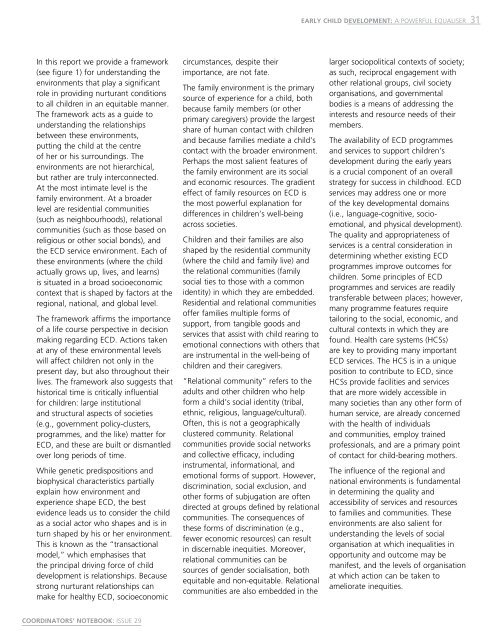A global call to action for early childhood
A global call to action for early childhood
A global call to action for early childhood
You also want an ePaper? Increase the reach of your titles
YUMPU automatically turns print PDFs into web optimized ePapers that Google loves.
Early child development: A powerful equaliser<br />
31<br />
In this report we provide a framework<br />
(see figure 1) <strong>for</strong> understanding the<br />
environments that play a significant<br />
role in providing nurturant conditions<br />
<strong>to</strong> all children in an equitable manner.<br />
The framework acts as a guide <strong>to</strong><br />
understanding the relationships<br />
between these environments,<br />
putting the child at the centre<br />
of her or his surroundings. The<br />
environments are not hierarchical,<br />
but rather are truly interconnected.<br />
At the most intimate level is the<br />
family environment. At a broader<br />
level are residential communities<br />
(such as neighbourhoods), relational<br />
communities (such as those based on<br />
religious or other social bonds), and<br />
the ECD service environment. Each of<br />
these environments (where the child<br />
actually grows up, lives, and learns)<br />
is situated in a broad socioeconomic<br />
context that is shaped by fac<strong>to</strong>rs at the<br />
regional, national, and <strong>global</strong> level.<br />
The framework affirms the importance<br />
of a life course perspective in decision<br />
making regarding ECD. Actions taken<br />
at any of these environmental levels<br />
will affect children not only in the<br />
present day, but also throughout their<br />
lives. The framework also suggests that<br />
his<strong>to</strong>rical time is criti<strong>call</strong>y influential<br />
<strong>for</strong> children: large institutional<br />
and structural aspects of societies<br />
(e.g., government policy-clusters,<br />
programmes, and the like) matter <strong>for</strong><br />
ECD, and these are built or dismantled<br />
over long periods of time.<br />
While genetic predispositions and<br />
biophysical characteristics partially<br />
explain how environment and<br />
experience shape ECD, the best<br />
evidence leads us <strong>to</strong> consider the child<br />
as a social ac<strong>to</strong>r who shapes and is in<br />
turn shaped by his or her environment.<br />
This is known as the “trans<strong>action</strong>al<br />
model,” which emphasises that<br />
the principal driving <strong>for</strong>ce of child<br />
development is relationships. Because<br />
strong nurturant relationships can<br />
make <strong>for</strong> healthy ECD, socioeconomic<br />
circumstances, despite their<br />
importance, are not fate.<br />
The family environment is the primary<br />
source of experience <strong>for</strong> a child, both<br />
because family members (or other<br />
primary caregivers) provide the largest<br />
share of human contact with children<br />
and because families mediate a child’s<br />
contact with the broader environment.<br />
Perhaps the most salient features of<br />
the family environment are its social<br />
and economic resources. The gradient<br />
effect of family resources on ECD is<br />
the most powerful explanation <strong>for</strong><br />
differences in children’s well-being<br />
across societies.<br />
Children and their families are also<br />
shaped by the residential community<br />
(where the child and family live) and<br />
the relational communities (family<br />
social ties <strong>to</strong> those with a common<br />
identity) in which they are embedded.<br />
Residential and relational communities<br />
offer families multiple <strong>for</strong>ms of<br />
support, from tangible goods and<br />
services that assist with child rearing <strong>to</strong><br />
emotional connections with others that<br />
are instrumental in the well-being of<br />
children and their caregivers.<br />
“Relational community” refers <strong>to</strong> the<br />
adults and other children who help<br />
<strong>for</strong>m a child’s social identity (tribal,<br />
ethnic, religious, language/cultural).<br />
Often, this is not a geographi<strong>call</strong>y<br />
clustered community. Relational<br />
communities provide social networks<br />
and collective efficacy, including<br />
instrumental, in<strong>for</strong>mational, and<br />
emotional <strong>for</strong>ms of support. However,<br />
discrimination, social exclusion, and<br />
other <strong>for</strong>ms of subjugation are often<br />
directed at groups defined by relational<br />
communities. The consequences of<br />
these <strong>for</strong>ms of discrimination (e.g.,<br />
fewer economic resources) can result<br />
in discernable inequities. Moreover,<br />
relational communities can be<br />
sources of gender socialisation, both<br />
equitable and non-equitable. Relational<br />
communities are also embedded in the<br />
larger sociopolitical contexts of society;<br />
as such, reciprocal engagement with<br />
other relational groups, civil society<br />
organisations, and governmental<br />
bodies is a means of addressing the<br />
interests and resource needs of their<br />
members.<br />
The availability of ECD programmes<br />
and services <strong>to</strong> support children’s<br />
development during the <strong>early</strong> years<br />
is a crucial component of an overall<br />
strategy <strong>for</strong> success in <strong>childhood</strong>. ECD<br />
services may address one or more<br />
of the key developmental domains<br />
(i.e., language-cognitive, socioemotional,<br />
and physical development).<br />
The quality and appropriateness of<br />
services is a central consideration in<br />
determining whether existing ECD<br />
programmes improve outcomes <strong>for</strong><br />
children. Some principles of ECD<br />
programmes and services are readily<br />
transferable between places; however,<br />
many programme features require<br />
tailoring <strong>to</strong> the social, economic, and<br />
cultural contexts in which they are<br />
found. Health care systems (HCSs)<br />
are key <strong>to</strong> providing many important<br />
ECD services. The HCS is in a unique<br />
position <strong>to</strong> contribute <strong>to</strong> ECD, since<br />
HCSs provide facilities and services<br />
that are more widely accessible in<br />
many societies than any other <strong>for</strong>m of<br />
human service, are already concerned<br />
with the health of individuals<br />
and communities, employ trained<br />
professionals, and are a primary point<br />
of contact <strong>for</strong> child-bearing mothers.<br />
The influence of the regional and<br />
national environments is fundamental<br />
in determining the quality and<br />
accessibility of services and resources<br />
<strong>to</strong> families and communities. These<br />
environments are also salient <strong>for</strong><br />
understanding the levels of social<br />
organisation at which inequalities in<br />
opportunity and outcome may be<br />
manifest, and the levels of organisation<br />
at which <strong>action</strong> can be taken <strong>to</strong><br />
ameliorate inequities.<br />
COORDINATORS’ NOTEBOOK: ISSUE 29
















